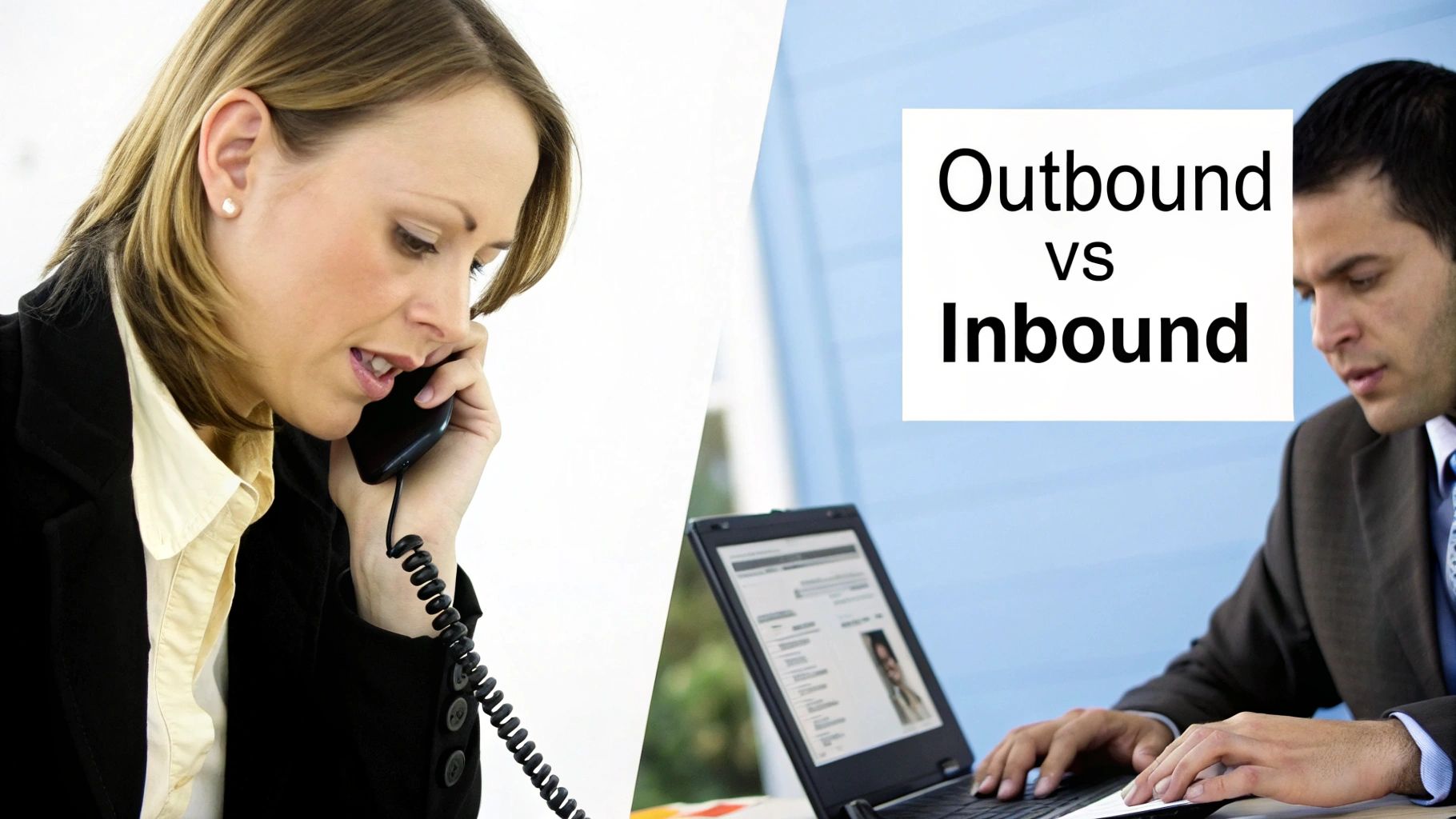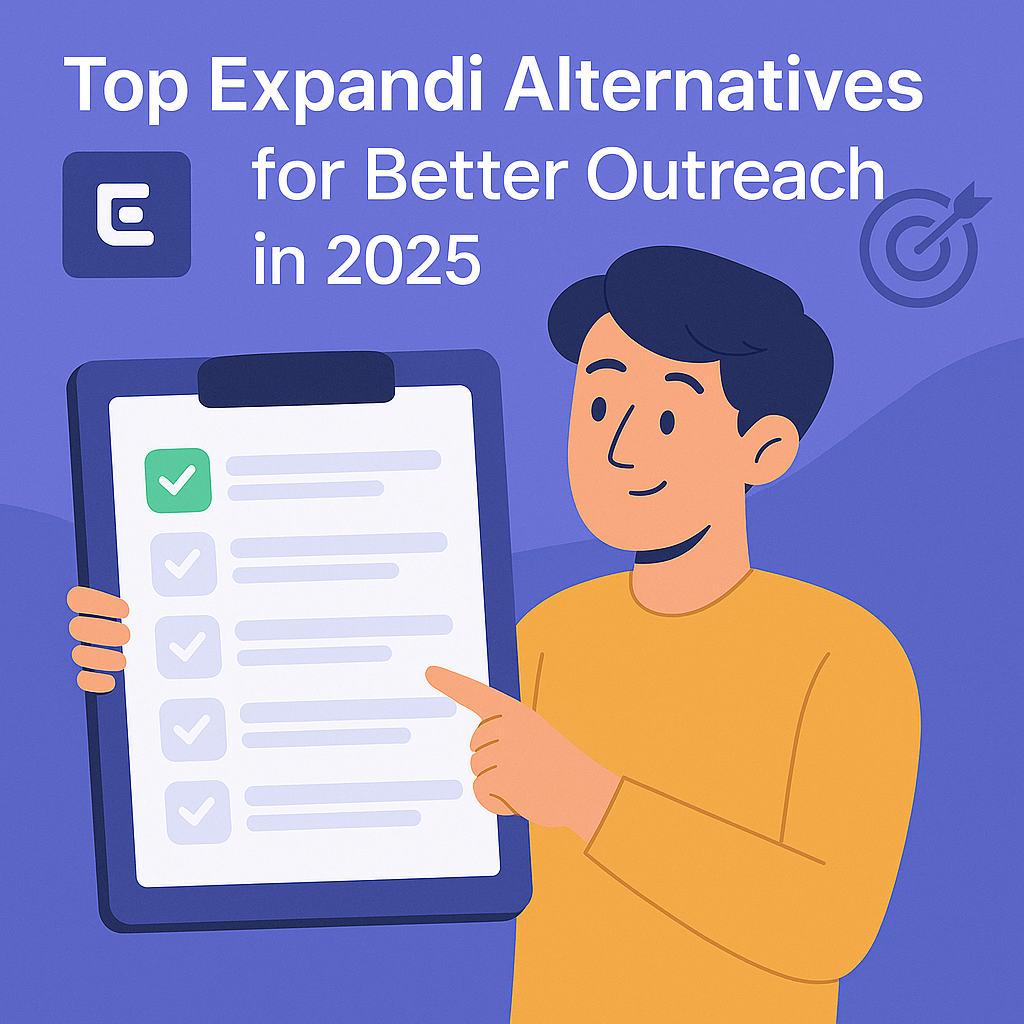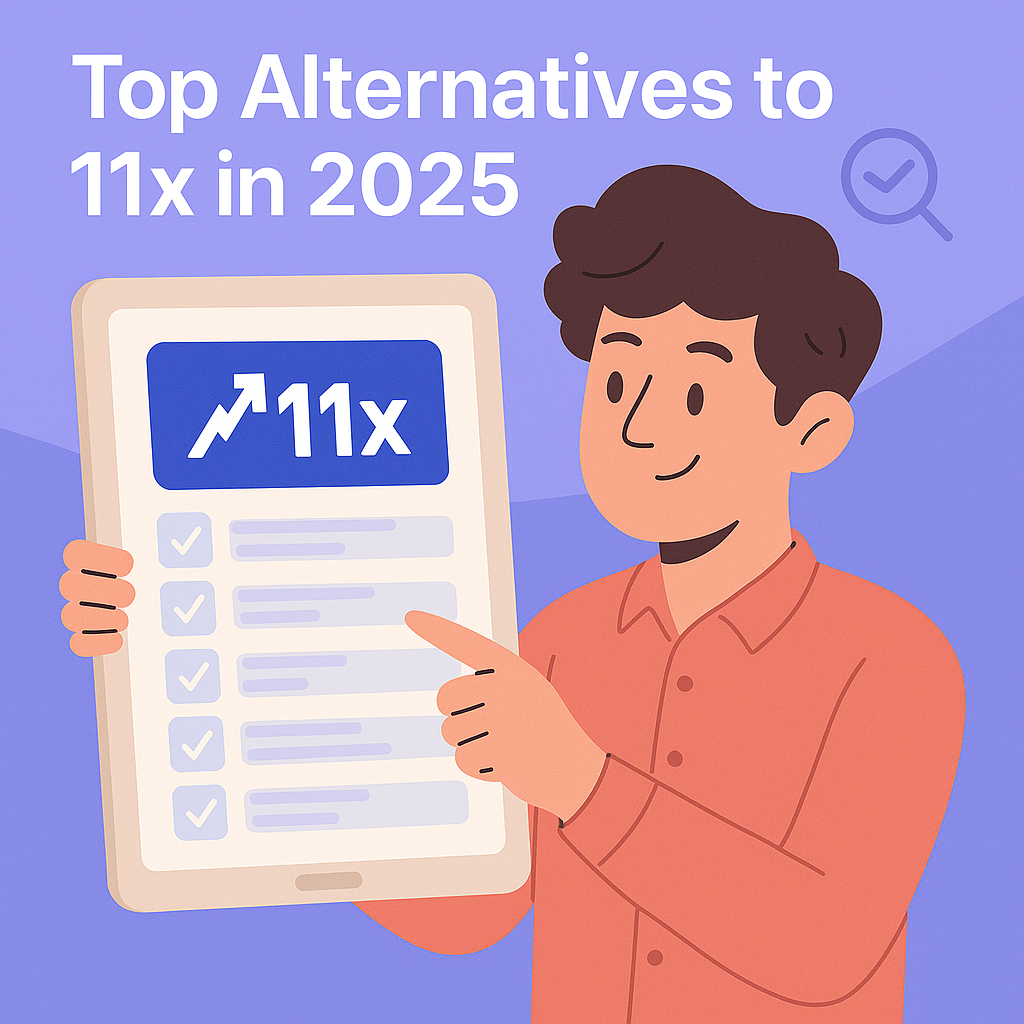Outbound Sales Definition: Our Guide to Winning Customers

If you’re just sitting around, waiting for customers to magically find you, you're playing a very long, frustrating game. You need to be proactive and discover the power of an outbound sales approach.
Outbound sales definition? It’s not about being a pushy telemarketer from a '90s movie. It’s the art of starting smart conversations with potential customers you know you can help. Instead of waiting for leads to find their way to you, you make the first move through well-researched calls, targeted emails, or direct messages.
Think of yourself less as a salesperson and more as a problem-solver on a mission, introducing people to solutions they might not even know exist yet.
What Is Outbound Sales, Really?
I still remember my first cold call; it was an absolute disaster that almost made me hang up my headset for good. 😅 Why? Because I had this idea that outbound sales was all about being an insistent salesperson who does all it takes to close a deal. I was dead wrong.

At its core, true outbound selling is about identifying a problem and reaching out directly to the person who has it, offering a genuine solution. It’s not about interrupting someone's day; it's about adding real value at just the right moment.
A passive, inbound approach is all about sitting by the phone, waiting for it to ring. Outbound flips that entire script on its head. It empowers you to:
- Target your ideal customers with laser-like precision.
- Control the timing and pace of your entire sales cycle.
- Get immediate feedback from the market on your messaging and your offer.
The core idea is simple: You don’t wait for opportunities to come to you; you go out and create them. That mindset shift is the real key to building a predictable revenue engine and growing your business on your own terms. 🚀
Outbound vs. Inbound Sales: A Practical Comparison
The difference between outbound and inbound sales is like fishing with a spear versus a net. That's probably the best way to think about it. It gets right to the heart of what makes each approach unique.
Let's break down the core differences between these two approaches to sales. One isn't inherently better than the other; they just play different roles in a healthy sales ecosystem.
What to NEVER do: Don't put all your eggs in one basket. A business that only does inbound is waiting by the phone, while one that only does outbound risks burning out its team and its reputation.
What to absolutely do: Build a hybrid model. Utilize your inbound efforts to establish brand authority and attract qualified leads. Then, use a targeted outbound strategy to go after your highest-value dream clients with surgical precision.
The Modern Outbound Sales Playbook
Let's get one thing straight: cold calling isn't dead. But generic, spray-and-pray outreach? That's been dead for years. 💀 The modern playbook is all about being smart, personal, and genuinely helpful. Forget blasting a thousand people with the same tired template; today, it’s all about precision targeting.

This means focusing on channels that actually foster connections. We're talking about targeted emails that get opened, LinkedIn messages that spark real conversations, and yes, even cold calls that land because you've done your homework.
Don't underestimate the power of a direct call. The global outbound telemarketing market was valued at a substantial USD 10.54 billion in 2024, underscoring its continued significance as a vital means of acquiring new customers.
From Cringe to Conversions
I have a confession: my early email templates were awful. Truly cringe-worthy. They were all about me, my company, and the features of my product. As you might expect, my reply rate was extremely low.
The Cringe-Worthy Template (What NEVER to do):
Hi [Name], My name is [My Name] from [My Company]. We offer a revolutionary platform that helps businesses like yours increase efficiency. I’d love to schedule a 15-minute demo to show you how we can help. Are you free next week?
It’s completely generic, selfish, and offers absolutely zero value to the person reading it. Now, let’s look at how a modern, high-performing email flips the script.
The High-Performing Template (What to absolutely do):
Hi [Name], I saw your recent post on LinkedIn about the challenges of scaling your SDR team. Your point about data accuracy really hit home. We helped [Similar Company] address that exact issue, which resulted in a 25% increase in booked meetings. Curious how you’re approaching this for Q3?
Night and day, right? The second version is personal, relevant, and starts a conversation focused on their problem, not your solution. This is the core of modern outbound.
To make this happen at scale, top teams rely on powerful sales automation platforms to manage these personalized touchpoints without getting overwhelmed.
This data-first approach, often supercharged by an AI SDR to pinpoint buying signals, transforms outbound from a guessing game into a precision sport. 💡 This is how you win in today's market.
How to Build Your First Outbound Campaign (Step-by-Step)
Alright, let's move past the theory and get our hands dirty. It's time to build your very first outbound campaign from the ground up. We're not talking about complicated systems or expensive software; this is a practical, step-by-step guide to get you rolling today.
Ready to dive in?
Step 1: Define Your Ideal Customer Profile (ICP)
Before you even think about writing an email or making a call, you have to know exactly who you're talking to. Who is your perfect customer? What challenges are keeping them up at night? Your Ideal Customer Profile (ICP) is the compass that guides every single decision you make from here on out.
ACTIONABLE POINT: Don't just guess. The best insights come from your happiest existing customers. Get on the phone with 3-5 of them and ask: "What was going on in your business that made you look for a solution like ours?" The words they use are pure gold for your messaging.
- What to do: Go deeper than just company size and industry. What's the specific job title? What software are they complaining about on LinkedIn?
- What NOT to do: NEVER assume you know your customer better than they know themselves. Listen first.
Step 2: Build a High-Quality Lead List
Once your ICP is crystal clear, you can begin searching for these people. Think about where they spend their time online. For many in B2B, LinkedIn Sales Navigator is an indispensable tool. But always remember: quality trumps quantity, every single time.
I once bought a cheap list of 10,000 "leads," thinking I'd struck gold. It was a complete disaster. The data was garbage; our email bounce rate skyrocketed, and our domain reputation suffered a significant decline. We booked zero meetings from it.
ACTIONABLE POINT: Manually build your first list of 50-100 prospects who are a perfect fit. It takes more time upfront, but the payoff in terms of relevance and response rates is huge. Use tools like LinkedIn Sales Navigator to find them and a tool like Hunter.io to get their email.
As you map out your strategy, ensure that you incorporate proven B2B lead generation best practices to set yourself up for success.
Step 3: Craft Your Message and Reach Out
Now for the fun part. The secret here is simple: make it about their problem, not your product's long list of features.
ACTIONABLE POINT: Use the "Personalize, Problem, Prove, Propose" framework.
- Personalize: "Saw your post on..." or "Noticed your company just..."
- Problem: State a common pain point you know their role faces.
- Prove: Briefly mention how you helped a similar company. (e.g., "We helped [Company X] cut down on [Problem] by 30%.")
- Propose: Ask a low-friction question. NOT "Can I have 15 minutes?" but "Open to seeing how we did it?"
- - What to do: Keep emails under 100 words. Plan 2-3 follow-ups, each adding new value or a fresh perspective.
- - What NOT to do: NEVER send a follow-up that just says "Just bumping this up." It adds zero value and is super annoying.
Why Outbound Sales Definition Is Your Secret Weapon
Of course, outbound sales generate revenue; that’s the primary objective. But the real magic lies in the benefits you don't see on a balance sheet.
When I was first starting out in sales, our early outbound efforts felt clumsy, as if we were just shouting into the void. But what we got back was invaluable: raw, unfiltered feedback straight from the market. 🗣️
That direct line to potential customers completely changed our product development. We stopped guessing what people needed because they were telling us exactly what they wanted (and didn't want) on our calls and in their email replies. That’s the secret weapon of proactive outreach.
It’s About More Than Just Hitting Quota
Outbound sales is really about taking the reins of your company's growth. It lets you build a predictable, repeatable pipeline, which means you can finally get off that terrifying revenue rollercoaster that so many young companies are stuck on.
Going on the offensive gives you the power to:
- Test a new message or market almost instantly. You get direct feedback in days, not months.
- Build your brand's authority by showing up in front of your dream clients before anyone else does.
- Create a more resilient business that isn't just sitting around waiting for leads to fall from the sky.
When you're proactive, you stop being a passenger and start driving your own sales destiny. You’re not just playing the game anymore; you're setting the rules. That’s how you build a company that’s meant to last. 💪
Time to Take Control
So, what’s the real outbound sales definition? It’s not a tactic; it’s a mindset. It’s about refusing to wait for success and going out to create it yourself. We've walked through the what, the why, and the how, from defining your ideal customer to crafting a message that actually gets replies.
You now have the exact playbook I wish I had when I started. The steps are simple, the tools are accessible, and the potential is massive. Don’t just read this and move on. Pick one thing and do it today.
Build a list of 10 dream customers. Draft one personalized email. Make one call. The momentum you build from that single action is what starts you winning.
Ready to stop guessing and start targeting high-intent leads on autopilot? GojiberryAI is your AI copilot for B2B prospecting. We identify leads that display real-time buying signals and deliver them directly to you, allowing you to focus on what matters: closing deals. Generate your pipeline today with GojiberryAI.
Frequently Asked Questions
Is Outbound Sales Still Effective Today?
Absolutely, but the game has changed entirely. The old approach of blasting out generic emails is dead on arrival. Today's outbound sales is a precision sport; it’s all about being highly targeted, deeply personalized, and guided by good data.
When done right, it's one of the best ways to get in front of high-value accounts that might never find you through a blog post or a Google ad.
How Much Time Should I Dedicate to Outbound Sales?
This really depends on your goals, but let me tell you, consistency is king. When I was a solo founder, I learned that even just 3-5 focused hours per week could make a real difference.
A massive, all-day blitz once a month is significantly less effective than setting aside a specific time each day for prospecting and outreach. Start with a manageable goal, like contacting 10 new, well-researched prospects daily, and then scale up.
What Are the Best Tools for a Beginner?
You absolutely do not need an expensive, complicated tech stack to get started. I made the mistake of over-investing in tools before I even had a solid process, and it was a huge waste of money. Focus on the essentials first.
- LinkedIn Sales Navigator: Non-negotiable for finding the right people at the right companies.
- A Free CRM: Something like the free version of HubSpot is perfect for keeping track of your conversations.
- An Email Finder: A tool like Hunter.io is a huge help for finding verified email addresses.
Remember, your most powerful 'tool' is a well-researched list and a message that actually resonates. Master the strategy first, then bring in technology to scale what's already working.
How Do I Handle Rejection in Sales?
Here’s the mindset shift that saved my sanity: rejection isn't personal; it's just data. 📊 Every single 'no' is a piece of feedback. It might mean the timing is off, you reached out to the wrong person, or your opening line needs some refinement.
The most successful reps I know see rejection as a filter. It just helps them get to the right conversation faster by weeding out the wrong ones. Keep your head down, learn from every interaction, and remember, you're looking for the right fit, not approval from everyone.
More High-Intent Leads = Your New Growth Engine.
Start Now and Get New High Intent Leads DeliveredStraight to Slack or Your Inbox.







.png)


